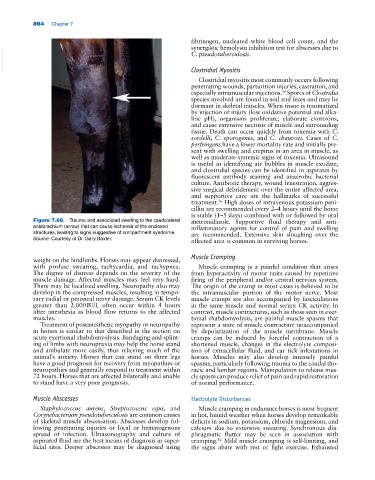Page 898 - Adams and Stashak's Lameness in Horses, 7th Edition
P. 898
864 Chapter 7
fibrinogen, nucleated white blood cell count, and the
synergistic hemolysin inhibition test for abscesses due to
VetBooks.ir Clostridial Myositis
C. pseudotuberculosis.
Clostridial myositis most commonly occurs following
penetrating wounds, parturition injuries, castration, and
especially intramuscular injections. Spores of Clostridia
56
species involved are found in soil and feces and may lie
dormant in skeletal muscles. When tissue is traumatized
by injection or injury (low oxidative potential and alka
line pH), organisms proliferate, elaborate exotoxins,
and cause extensive necrosis of muscle and surrounding
tissue. Death can occur quickly from toxemia with C.
sordelli, C. sporogenes, and C. chauvoei. Cases of C.
perfringens have a lower mortality rate and initially pre
sent with swelling and crepitus in an area in muscle, as
well as moderate systemic signs of toxemia. Ultrasound
is useful in identifying air bubbles in muscle exudate,
and clostridial species can be identified in aspirates by
fluorescent antibody staining and anaerobic bacterial
culture. Antibiotic therapy, wound fenestration, aggres
sive surgical debridement over the entire affected area,
and supportive care are the hallmarks of successful
56
treatment. High doses of intravenous potassium peni
cillin are recommended every 2–4 hours until the horse
is stable (1–5 days) combined with or followed by oral
Figure 7.68. Trauma and associated swelling to the caudolateral metronidazole. Supportive fluid therapy and anti‐
antebrachium (arrow) that can cause ischemia of the enclosed inflammatory agents for control of pain and swelling
structures, leading to signs suggestive of compartment syndrome. are recommended. Extensive skin sloughing over the
Source: Courtesy of Dr. Gary Baxter.
affected area is common in surviving horses.
Muscle Cramping
weight on the hindlimbs. Horses may appear distressed,
with profuse sweating, tachycardia, and tachypnea. Muscle cramping is a painful condition that arises
The degree of distress depends on the severity of the from hyperactivity of motor units caused by repetitive
muscle damage. Affected muscles may feel very hard. firing of the peripheral and/or central nervous system.
There may be localized swelling. Neuropathy also may The origin of the cramp in most cases is believed to be
develop in the compressed muscles, resulting in tempo the intramuscular portion of the motor nerve. Most
rary radial or peroneal nerve damage. Serum CK levels muscle cramps are also accompanied by fasciculations
greater than 2,000 IU/L often occur within 4 hours in the same muscle and normal serum CK activity. In
after anesthesia as blood flow returns to the affected contrast, muscle contractures, such as those seen in exer
muscles. tional rhabdomyolysis, are painful muscle spasms that
Treatment of postanesthetic myopathy or neuropathy represent a state of muscle contracture unaccompanied
in horses is similar to that described in the section on by depolarization of the muscle membrane. Muscle
acute exertional rhabdomyolysis. Bandaging and splint cramps can be induced by forceful contraction of a
ing of limbs with neuropraxia may help the horse stand shortened muscle, changes in the electrolyte composi
and ambulate more easily, thus relieving much of the tion of extracellular fluid, and ear tick infestations in
animal’s anxiety. Horses that can stand on three legs horses. Muscles may also develop intensely painful
have a good prognosis for recovery from myopathies or spasms, particularly following trauma to the caudal tho
neuropathies and generally respond to treatment within racic and lumbar regions. Manipulation to release mus
72 hours. Horses that are affected bilaterally and unable cle spasm can produce relief of pain and rapid restoration
to stand have a very poor prognosis. of normal performance.
Muscle Abscesses Electrolyte Disturbances
Staphylococcus aureus, Streptococcus equi, and Muscle cramping in endurance horses is most frequent
Corynebacterium pseudotuberculosis are common causes in hot, humid weather when horses develop remarkable
of skeletal muscle abscessation. Abscesses develop fol deficits in sodium, potassium, chloride magnesium, and
lowing penetrating injuries or local or hematogenous calcium due to extensive sweating. Synchronous dia
spread of infection. Ultrasonography and culture of phragmatic flutter may be seen in association with
aspirated fluid are the best means of diagnosis in super cramping. Mild muscle cramping is self‐limiting, and
12
ficial sites. Deeper abscesses may be diagnosed using the signs abate with rest or light exercise. Exhausted

